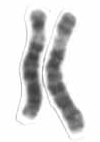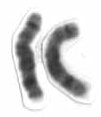Related Research Articles

In genetics, a locus is a specific, fixed position on a chromosome where a particular gene or genetic marker is located. Each chromosome carries many genes, with each gene occupying a different position or locus; in humans, the total number of protein-coding genes in a complete haploid set of 23 chromosomes is estimated at 19,000–20,000.

Chromosome 6 is one of the 23 pairs of chromosomes in humans. People normally have two copies of this chromosome. Chromosome 6 spans more than 170 million base pairs and represents between 5.5 and 6% of the total DNA in cells. It contains the Major Histocompatibility Complex, which contains over 100 genes related to the immune response, and plays a vital role in organ transplantation.

Chromosome 22 is one of the 23 pairs of chromosomes in human cells. Humans normally have two copies of chromosome 22 in each cell. Chromosome 22 is the second smallest human chromosome, spanning about 49 million DNA base pairs and representing between 1.5 and 2% of the total DNA in cells.

Chromosome 8 is one of the 23 pairs of chromosomes in humans. People normally have two copies of this chromosome. Chromosome 8 spans about 145 million base pairs and represents between 4.5 and 5.0% of the total DNA in cells.

Chromosome 16 is one of the 23 pairs of chromosomes in humans. People normally have two copies of this chromosome. Chromosome 16 spans about 90 million base pairs and represents just under 3% of the total DNA in cells.

Chromosome 19 is one of the 23 pairs of chromosomes in humans. People normally have two copies of this chromosome. Chromosome 19 spans more than 58.6 million base pairs, the building material of DNA.
FXYD6, or FXYD domain-containing ion transport regulator 6, is a gene which is located at the 11q23.3. The FXYD6 protein contains 95 amino acids, and can be found in all human tissues except blood.

Trace amine associated receptor 6, also known as TAAR6, is a protein which in humans is encoded by the TAAR6 gene.

Neuronal acetylcholine receptor subunit alpha-7, also known as nAChRα7, is a protein that in humans is encoded by the CHRNA7 gene. The protein encoded by this gene is a subunit of certain nicotinic acetylcholine receptors (nAchR).

The Abelson helper integration site 1 (AHI1) is a protein coding gene that is known for the critical role it plays in brain development. Proper cerebellar and cortical development in the human brain depends heavily on AHI1. The AHI1 gene is prominently expressed in the embryonic hindbrain and forebrain. AHI1 specifically encodes the Jouberin protein and mutations in the expression of the gene is known to cause specific forms of Joubert syndrome. Joubert syndrome is autosomal recessive and is characterized by the brain malformations and mental retardation that AHI1 mutations have the potential to induce. AHI1 has also been associated with schizophrenia and autism due to the role it plays in brain development. An AHI1 heterozygous knockout mouse model was studied by Bernard Lerer and his group at Hadassah Medical Center in Jerusalem to elucidate the correlation between alterations in AHI1 expression and the pathogenesis of neuropsychiatric disorders. The core temperatures and corticosterone secretions of the heterozygous knockout mice after exposure to environmental and visceral stress exhibited extreme repression of autonomic nervous system and hypothalamic-pituitary-adrenal responses. The knockout mice demonstrated an increased resilience to different types of stress and these results lead to a correlation between emotional regulation and neuropsychiatric disorders.

Suppressor of tumorigenicity protein 7 is a protein that in humans is encoded by the ST7 gene. ST7 orthologs have been identified in all mammals for which complete genome data are available.

Synapsin-3 is a protein that in humans is encoded by the SYN3 gene.

Protein DGCR6 is a protein that in humans is encoded by the DGCR6 gene.

Zinc finger protein 804A is a protein that in humans is encoded by the ZNF804A gene. The human gene maps to chromosome 2 q32.1 and consists of 4 exons that code for a protein of 1210 amino acids.
The Center for Applied Genomics is a research center at the Children's Hospital of Philadelphia that focuses on genomics research and the utilization of basic research findings in the development of new medical treatments.
1q21.1 deletion syndrome is a rare aberration of chromosome 1. A human cell has one pair of identical chromosomes on chromosome 1. With the 1q21.1 deletion syndrome, one chromosome of the pair is not complete, because a part of the sequence of the chromosome is missing. One chromosome has the normal length and the other is too short.

1q21.1 duplication syndrome or 1q21.1 (recurrent) microduplication is a rare aberration of chromosome 1.
Apolipoprotein L is found in high-density lipoprotein complexes that plays a central role in cholesterol transport. The cholesterol content of membranes is important in cellular processes such as modulating gene transcription and signal transduction both in the adult brain and during neurodevelopment. There are six apo L genes located in close proximity to each other on chromosome 22q12 in humans. 22q12 is a confirmed high-susceptibility locus for schizophrenia and close to the region associated with velocardiofacial syndrome that includes symptoms of schizophrenia.
Insulin-dependent diabetes mellitus (IDDM) is a genetic heterogenouse autoimmune disorder, which is triggered by genetic predisposition and environmental factors. The prevalence of insulin-dependent diabetes mellitus (IDDM) among children and young adult from Europe is approximately 0.4%. Insulin-dependent diabetes mellitus (IDDM) is characterized by acute onset and insulin deficiency. Patients with insulin-dependent diabetes mellitus (IDDM) are found with gradual loss of the pancreatic islet beta cells and therefore not able to produce insulin. As a result, they usually need exogenous insulin to maintain their life.

UPF0739 protein C1orf74 is a protein that in humans is encoded by the C1orf74 gene.
References
- ↑ "Human PubMed Reference:". National Center for Biotechnology Information, U.S. National Library of Medicine.
- ↑ "Entrez Gene: Schizophrenia susceptibility locus, chromosome 10q-related" . Retrieved 2017-11-29.